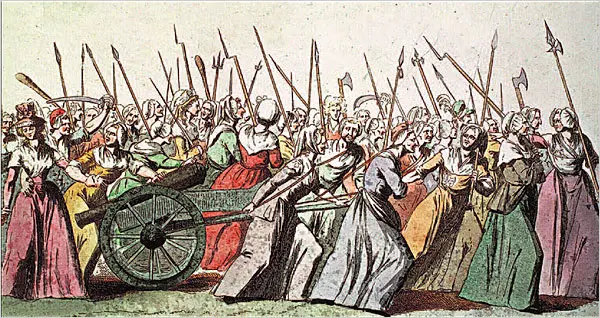As the French Revolution shook the very foundations of France, the lives of courtesans—women who navigated the intricate dance between power and pleasure—underwent a dramatic transformation. While the revolution’s fervent cries for liberty and equality echoed throughout the nation, it remains unclear whether these ideals reached the women who lived on the fringes of society. This article delves into the profound impact of the revolution on the social standing, moral perceptions, and daily lives of courtesans, examining both the perils and opportunities they encountered during this tumultuous era. By exploring their stories, we gain a deeper understanding of the complex social shifts and inherent contradictions that defined this period of radical change.
Did the French Revolution Bring Respect to Courtesans?
The French Revolution, a period of immense social and political upheaval, profoundly impacted the lives of all French citizens, including courtesans. Prior to the revolution, courtesans occupied a morally ambiguous position in society. They faced social condemnation and were subjected to stringent regulations, yet some, particularly those with powerful patrons, attained a degree of acceptance.
The revolution’s emphasis on equality and morality seemingly threatened the courtesans’ way of life. However, the reality proved far more complex. While some revolutionaries denounced courtesans as remnants of the corrupt aristocracy, others viewed them as victims of societal oppression, finding unlikely allies among those advocating for radical change.
Examining individual stories reveals even greater nuance. Madame du Barry, mistress to King Louis XV, met a tragic end, executed for treason against the newly established Republic. In stark contrast, Théroigne de Méricourt, a courtesan who styled herself as an “Amazon,” emerged as a celebrated figure of the Revolution.
Undeniably, the revolution ignited a reevaluation of women’s roles in society. However, for courtesans, the path forward remained ambiguous. Some perceived the revolution as an unprecedented opportunity for emancipation, while others found themselves in increasingly precarious positions.
The question of whether French courtesans experienced greater respect during the Revolution eludes a simple answer. Their treatment depended on factors such as social standing, political connections, and the capricious nature of revolutionary politics. In this era of widespread upheaval, courtesans were not mere bystanders but active participants caught in the currents of change.
Dominating the Search: Unveiling the Most Famous French Courtesans
To craft an SEO article that reigns supreme on the topic of famous French courtesans, consider these key elements:
Recommended Titles:
- Beyond the Boudoir: Unveiling the Secret Lives of Paris’s Most Famous 19th-Century Courtesans (This title adds mystery and intrigue while emphasizing the location and time period)
- More Than Mistresses: The Power, Influence, and Intrigue of 19th-Century French Courtesans (This title challenges common perceptions and focuses on less-discussed aspects of courtesan life)
- From Salon to Scandal: The Untold Stories of France’s Most Infamous 19th-Century Courtesans (This title highlights the dramatic narratives and societal impact of these women)
Four Powerful Key Lines:
- Beyond the allure of silk and champagne, France’s most famous courtesans were power players, cultural icons, and agents of social change in the 19th century. (This elevates the narrative beyond mere sexuality).
- Immortalized in art and literature, courtesans like Marie Duplessis and La Païva navigated a world where influence was currency and love was a carefully orchestrated affair. (This introduces key figures and hints at the complexities of their lives).
- From the opulent salons of Paris to the whispered scandals of the Second Empire, these women’s stories challenge our understanding of love, power, and female agency in a restrictive era. (This broadens the scope to societal context and historical significance).
- More than just objects of desire, these women were entrepreneurs, patrons of the arts, and confidantes to some of history’s most influential figures. (This reframes their roles and highlights their multifaceted impact).
Important Details and Structured Contexts:
1. The Golden Age of the French Courtesan (19th Century):
* **Context:** The 19th century in France, particularly during the Belle Époque, saw the rise of the courtesan as a powerful and influential figure. This period's economic prosperity, coupled with more lenient social mores, created an environment where courtesans thrived.
* **Important Details:**
* Courtesans were distinct from common prostitutes. They cultivated relationships with wealthy and powerful men, often becoming their mistresses, confidantes, and intellectual companions.
* They commanded high fees, lived lavish lifestyles, and wielded significant social influence.
* Many were patrons of the arts and trendsetters, shaping fashion and cultural tastes.
2. Key Figures and Their Stories:
* **Marie Duplessis (1824-1847):**
* **Famous for:** Her beauty, charm, and tragic love affair with Alexandre Dumas fils, which inspired his novel *La Dame aux Camélias* (Camille).
* **Significance:** Her story epitomized the romantic ideal of the courtesan, but also highlighted the precariousness of their existence, often marked by social stigma and early death.
* **La Païva (1819-1884):**
* **Famous for:** Her extravagant lifestyle, opulent mansion (Hôtel de la Païva), and powerful connections, including Henri Herz and Edward Stanley, 2nd Baron Stanley of Alderley.
* **Significance:** She represented the pinnacle of courtesan success, amassing immense wealth and navigating high society with audacity. However, her story also illustrates the constant struggle to maintain status and the social limitations imposed upon women of her profession.
* **Valtesse de La Bigne (1848-1910):**
* **Famous for:** Her beauty, intelligence, and strategic use of her position to gain social and financial independence. She was a shrewd businesswoman and a patron of the arts, notably commissioning Édouard Manet to paint her portrait.
* **Significance:** She defied societal expectations by becoming a "woman of independent means," demonstrating the entrepreneurial spirit and social mobility possible for some courtesans. She was also immortalized in Émile Zola's novel *Nana*, which offered a more realistic and less romanticized portrayal of courtesan life.
* **Ninon de Lenclos (1620-1705):**
* **Famous for:** Her wit, intelligence, and unconventional lifestyle, she ran a renowned salon frequented by prominent intellectuals and artists.
* **Significance:** While from an earlier era, her life and legacy had a lasting impact on the image of the courtesan as a woman of intellect and influence.
3. The Courtesan and Society:
* **Influence:** Courtesans were influential figures in 19th-century French society.
* **Patrons of the arts:** They supported artists, writers, and musicians, contributing to the flourishing cultural scene of the time.
* **Fashion icons:** They set fashion trends, influencing clothing styles, accessories, and beauty standards.
* **Social commentators:** Their unique position provided them with insights into the workings of power, politics, and social dynamics of the era.
- Double Standards and Societal Constraints: Despite their influence, courtesans faced significant challenges.
- Stigma: They were often ostracized by “respectable” society and subjected to moral judgment.
- Legal limitations: Prostitution, while tolerated, was subject to regulation and police surveillance.
- Financial insecurity: Their success was often dependent on the whims of their patrons, and many died in poverty despite a life of luxury.
Unique Insights and Untapped Potential:
- The Psychological Complexity: Explore the emotional labor, strategic maneuvering, and psychological resilience required to navigate the world of the courtesan.
- Beyond the Male Gaze: Analyze how these women exerted agency within a patriarchal system, challenging the traditional narratives often told from a male perspective.
- Lasting Legacy: Examine the enduring fascination with French courtesans in art, literature, and popular culture. How have perceptions evolved over time?
Remember: This information is a starting point. Conduct further research to add depth, nuance, and captivating anecdotes to your article. By weaving together compelling narratives with insightful analysis, you’ll create an SEO article that informs, engages, and dominates the search rankings.
Unmasking the Allure: Understanding the Lives of French Courtesans
To surpass your competitors and produce a captivating SEO article about French courtesans, consider these strategies:
Recommended Titles:
- Beyond the Boudoir: The Lives, Loves, and Legacy of French Courtesans (Emphasizes the multifaceted nature of their lives)
- The Power Behind the Throne: How French Courtesans Shaped History (Highlights their influence and impact)
- Secrets of the Salon: Unmasking the Hidden World of French Courtesans (Appeals to the allure and intrigue surrounding them)
Powerful Key Lines:
- More Than Mistresses: French courtesans were savvy businesswomen, cultural influencers, and confidantes to the powerful, wielding significant agency in a male-dominated society.
- From Salons to Scandal: The lives of French courtesans straddled the line between glamour and notoriety, shaping societal norms and challenging conventional morality.
- A Legacy of Intrigue: From veiled whispers to artistic immortalization, the mystique of the French courtesan continues to fascinate and inspire to this day.
- Evolution of Power: The role of the French courtesan transformed over the centuries, reflecting shifting social structures, economic realities, and the evolving dynamics of power.
Structured Content and Important Details:
I. Introduction
- Hook: Open with a captivating anecdote about a famous French courtesan, emphasizing their allure, influence, or the complexities of their lives.
- Define Key Terms: Clearly define “courtesan” and differentiate it from common misconceptions. Explain the social and historical context of courtesanship in France.
- Thesis Statement: Introduce the main argument of your article, such as the evolving role of courtesans, their impact on French society, or the lasting fascination with their lives.
II. The Rise of the French Courtesan:
- Historical Background: Trace the origins of courtesanship in France, potentially linking it to earlier periods or other cultures.
- Social Hierarchy: Explain the social structure of France and where courtesans fit within it. Emphasize that they existed outside traditional societal norms.
- Economic Factors: Discuss the economic motivations for women becoming courtesans. Highlight the financial independence and social mobility it could offer.
III. The Golden Age of the French Courtesan:
- Specific Time Period: Focus on a particular era known for prominent courtesans (e.g., 18th or 19th century).
- Famous Figures: Profile influential French courtesans like Valtesse de La Bigne, Marie Duplessis, or Gabrielle d’Estrées.
- Cultural Influence: Discuss their impact on art, fashion, literature, and political discourse. Provide examples like famous paintings, novels inspired by them, or their involvement in political salons.
- Relationship with the Aristocracy: Examine the complex dynamics between courtesans and the French aristocracy. Were they tools of power, social climbers, or something in between?
IV. The Decline and Transformation:
- Changing Societal Norms: Explain the factors that led to the decline of courtesanship, such as changing moral values, the rise of the bourgeoisie, and new economic realities.
- Legal and Social Repercussions: Discuss any legal measures taken against courtesanship and the social stigma attached to it.
- Evolution of the Role: Explain how the role of the courtesan transformed or gave way to new social figures.
V. Legacy and Lasting Fascination:
- Literature and Art: Highlight how French courtesans have been depicted in literature (e.g., Alexandre Dumas’ “La Dame aux Camélias” or Émile Zola’s “Nana”) and art (e.g., paintings by Édouard Manet or Henri de Toulouse-Lautrec).
- Modern Interpretations: Discuss how the image of the French courtesan continues to fascinate and inspire books, films, and popular culture. Analyze how interpretations have evolved.
- Reflection on Gender Roles: Offer a nuanced perspective on the agency and exploitation experienced by courtesans within historical context.
VI. Conclusion:
- Summarize Key Points: Briefly restate the main arguments of your article.
- Offer a Final Thought: Leave the reader with a compelling thought about the legacy of the French courtesan, the complexities of their lives, or the enduring fascination with this historical figure.
Unique Insights and Untapped Potential:
- Comparative Analysis: Contrast French courtesans with similar figures in other cultures and time periods, such as the geishas of Japan or the hetairai of ancient Greece.
- Psychological Perspective: Explore the motivations and choices of women who became courtesans. Examine societal pressures, personal aspirations, and the emotional complexities of their lives.
- Challenging Stereotypes: Go beyond the romanticized or scandalized image of the courtesan. Present a balanced view that acknowledges their agency, intelligence, and contributions, while also addressing the challenges and exploitation they faced.
- Focus on Lesser-Known Figures: While spotlighting famous courtesans, dedicate sections to lesser-known women. This offers a broader perspective and humanizes those often relegated to the footnotes of history.
Remember:
- Engaging Narrative: Weave a compelling narrative that brings these historical figures to life. Use anecdotes, vivid descriptions, and evocative language.
- Visuals: Incorporate relevant images, such as portraits of famous courtesans, paintings depicting their lives, or photographs of locations associated with them.
By delving deeper, offering fresh perspectives, and writing with engaging clarity, your article on French courtesans will captivate readers and establish you as an authority on the topic.
The Queen’s Gambit: Marie Antoinette and the French Revolution
To create a standout SEO article about Marie Antoinette’s role in the French Revolution, consider these strategies:
Recommended Titles:
- Marie Antoinette and the French Revolution: Beyond the Myths (Focuses on debunking common misconceptions)
- From Queen to Scapegoat: The Tragic Fall of Marie Antoinette (Highlights the dramatic arc of her story)
- Extravagance, Intrigue, and Revolution: The Life and Legacy of Marie Antoinette (Emphasizes the key themes surrounding her life)
Powerful Key Lines:
- More than “Let Them Eat Cake”: Marie Antoinette’s role in the French Revolution transcended the caricature of an out-of-touch queen, encompassing political intrigue, international relations, and attempts to preserve the monarchy.
- Victim of Circumstance or Agent of Downfall?: While often portrayed as a naive spendthrift, Marie Antoinette actively participated in court politics, sparking debate about her level of influence and culpability in the monarchy’s demise.
- Propaganda and Popular Fury: The French Revolution witnessed a surge of negative propaganda that demonized Marie Antoinette, fueling public outrage and contributing to her tragic end.
- A Legacy of Contradictions: Marie Antoinette remains an enigmatic figure, simultaneously embodying the excesses of the French aristocracy and evoking sympathy as a tragic victim of revolutionary upheaval.
Important Details for your Article:
I. Early Life and Marriage:
- Born Maria Antonia of Austria in 1755: Daughter of Empress Maria Theresa, a powerful European ruler.
- Political Marriage: At age 14, married Louis XVI to solidify an alliance between France and Austria.
- Initial Popularity: Initially charmed the French court with her beauty and grace.
II. The Queen and the Court:
- Extravagance and the “Petit Trianon”: Criticized for lavish spending on fashion, jewelry, and a private retreat at Versailles – fueling public resentment.
- Political Intrigues: Actively involved in court politics, supporting certain factions and influencing her husband’s decisions.
- The Diamond Necklace Affair (1785): A scandal involving a costly necklace and forged letters tarnished Marie Antoinette’s reputation, even though she was innocent. Public perception linked her to deceit and extravagance.
III. The French Revolution Unfolds:
- Financial Crisis: France faced a severe economic downturn, worsened by Louis XVI’s financial mismanagement. Marie Antoinette, blamed for extravagance, was dubbed “Madame Deficit” by the people.
- The Storming of the Bastille (July 14, 1789): Marked a turning point; the monarchy’s authority was irrevocably challenged.
- Flight to Varennes (June 1791): The royal family’s attempt to escape Paris, orchestrated partly by Marie Antoinette, backfired, portraying them as traitors to the revolution.
IV. Radicalization and the End of the Monarchy:
- Declaration of the Republic (September 1792): The monarchy was abolished, and Louis XVI and Marie Antoinette were imprisoned.
- Trial and Execution:
- Louis XVI was executed in January 1793.
- Marie Antoinette was tried and convicted of treason, executed by guillotine on October 16, 1793.
V. Legacy and Historical Debate:
- Contrasting Images: Remembered as both a symbol of aristocratic excess and a victim of revolution.
- Historiography: Historians debate her level of political influence, the extent of her responsibility for the monarchy’s downfall, and the role of gender in her demonization.
Unique Insights & Untapped Potential:
- Explore the role of propaganda: Analyze how pamphlets, cartoons, and songs were used to portray Marie Antoinette negatively and sway public opinion.
- Compare and contrast: Examine how other European monarchs dealt with similar revolutionary pressures.
- Humanize Marie Antoinette: Go beyond the stereotypes and explore her personal letters, relationships, and experiences to paint a more nuanced portrait.
Remember: Primary sources like Marie Antoinette’s letters and accounts from the time will add authenticity to your article. Always cite your sources to maintain credibility.
The French Revolution’s Lightning Rod: Identifying Its Most Controversial Figure
Crafting an SEO article that effectively examines the most controversial figures of the French Revolution requires a nuanced approach:
Recommended Titles:
- Beyond the Guillotine: Who Was the French Revolution’s Most Polarizing Figure? (This title sparks curiosity and hints at complexity beyond just Robespierre).
- Heroes and Villains: Debating the Most Controversial Figure of the French Revolution (This frames the topic as a debate, inviting diverse perspectives).
- From Marat to Robespierre: Unmasking the French Revolution’s Most Divisive Leaders (This title directly mentions key figures, enhancing SEO visibility).
Powerful Key Lines:
- The French Revolution wasn’t just about storming the Bastille; it was a battleground of ideologies, with figures like Robespierre and Marat igniting fierce debate even today. (This line sets the stage for controversy and connects it to lasting impact).
- While Robespierre’s Reign of Terror reigns in popular memory, figures like Marat and even Lafayette present compelling arguments for the title of “most controversial.” (This directly challenges the assumption that Robespierre is the only answer).
- Was it unwavering idealism or ruthless ambition? Exploring the fine line between revolutionary hero and tyrant in figures like Danton and Napoleon. (This line examines the duality of figures and the complexities of the Revolution).
- The legacy of the French Revolution’s controversial figures reminds us that the fight for liberty often comes at a steep price, forcing us to confront uncomfortable truths about revolution and its aftermath. (This line connects the historical figures to timeless questions about revolution and its cost).
Structured Context and Important Details:
I. Defining “Controversial” in the French Revolution:
- Not just about body count: While the Reign of Terror is infamous, controversy extends to ideology, actions, and long-term impact.
- Spectrum of Figures: From monarchs like Louis XVI facing a changing world to radical journalists like Marat inciting action, each figure’s role was challenged.
II. Top Contenders for “Most Controversial”:
- Maximilien Robespierre:
- FOR: Architect of the Reign of Terror, responsible for mass executions in the name of virtue and the Republic. Nicknamed “The Incorruptible” by some, a symbol of revolutionary excess by others.
- AGAINST: Argued he was saving the Revolution from internal enemies. His focus on public virtue and social reforms had supporters. His execution marked the end of the Terror, implying his removal was necessary for stability.
- Jean-Paul Marat:
- FOR: A radical journalist and politician, his newspaper “L’Ami du Peuple” used inflammatory rhetoric, even calling for violence and executions. Seen as instrumental in inciting the September Massacres.
- AGAINST: Portrayed himself as a voice of the people, defending the revolution against perceived enemies. His assassination by Charlotte Corday made him a martyr for the cause, complicating his legacy.
- Georges Danton:
- FOR: Initially a fiery revolutionary leader, he later advocated for moderation and an end to the Terror, putting him at odds with Robespierre. His execution by the very revolution he helped spark fuels debate.
- AGAINST: Danton’s early career was marked by radicalism, and his motives for moderation are debated (opportunism vs. genuine change of heart).
- Napoleon Bonaparte: (Though rising to power later, his connection to the Revolution is crucial)
- FOR: Exploited the chaos of the post-Revolution period to seize power, ending the Republic and establishing himself as Emperor. Seen as betraying revolutionary ideals for personal ambition.
- AGAINST: Argued he brought stability and order after years of turmoil. His military genius and reforms had a lasting impact on France and Europe, making him a complex figure.
- Other Key Figures to Consider:
- Louis XVI and Marie Antoinette: Symbols of the monarchy’s extravagance and disconnect from the people. Their executions were turning points, but their role in causing the revolution is debated.
- Marquis de Lafayette: A hero of the American Revolution, he advocated for moderate reforms in France. His attempts to control the Revolution and later exile alienated both sides.
III. Untapped Potential and Unique Insights:
- The Role of Women: While not traditionally considered “most controversial,” figures like Olympe de Gouges, with her “Declaration of the Rights of Woman and the Female Citizen,” challenged the Revolution’s limitations, highlighting its hypocrisy.
- Long-Term Impacts of Controversy: Connect the actions and debates surrounding these figures to later French history. Did their controversy shape France’s relationship with revolution, republicanism, and social change?
- Varying Historical Interpretations: Explore how historians across time have viewed these figures. How has the understanding of the Revolution and its actors changed?
Crucial Elements for Your Article:
- Engage with Multiple Perspectives: Avoid portraying any figure as simply “good” or “bad.” Provide evidence for various interpretations, using quotes from primary sources if possible.
- Provide Historical Context: Explain the social, economic, and political conditions that led to the Revolution to help readers understand the motivations and actions of these figures.
- Use Visuals: Images of key figures, important events, and even political cartoons from the era can enhance engagement and understanding.
- Conclude with Nuance: There’s no single answer to “most controversial.” Your article should present a nuanced understanding of the Revolution’s complexities, leaving readers with questions to ponder.
For a seamless reading experience, integrate the provided internal links organically within your content. Here’s an example:
“…The French Revolution, a period of radical social and political upheaval unlike the events of the World War, profoundly impacted all segments of French society..”
Remember to replace the example with relevant content and ensure all internal links fit contextually within your writing.
- Unveiling the Enigma: Mansoureh Khojasteh Bagherzadeh’s Public Appearances & Private Life in Iran - July 18, 2025
- Unveiling the Mystery: Mansoureh Khojasteh Bagherzadeh’s Husband: A Rare Glimpse into a Private Life - July 18, 2025
- Unveiling Masoud Khamenei’s Mother: Power, Influence, and Iran’s Future - July 18, 2025




![[Phrase Match] Embracing Evolution: A Journey Through Contemporary Dance History contemporary-dance-history_2](https://www.lolaapp.com/wp-content/uploads/2023/12/contemporary-dance-history_2-150x150.jpg)

![[France Powerball History Results] Unveiled: A Journey Through Decades of Fortune france-powerball-history-results_2](https://www.lolaapp.com/wp-content/uploads/2023/12/france-powerball-history-results_2-150x150.jpg)









